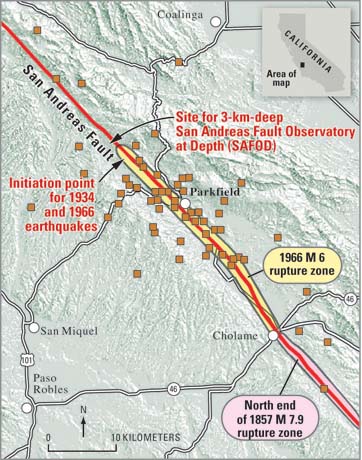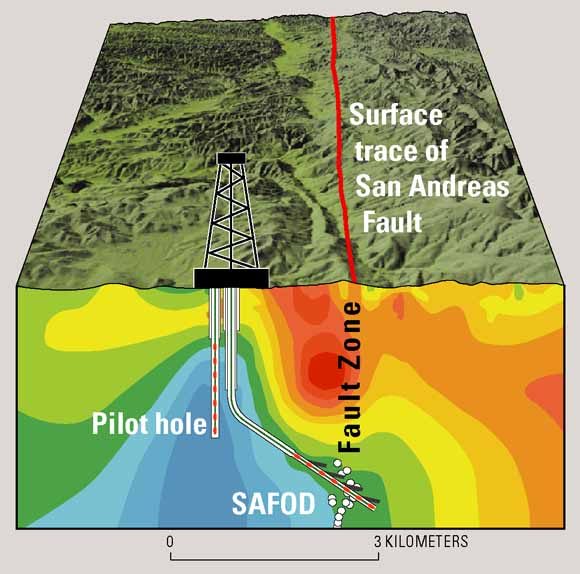



| To better understand what happens on and near a fault before, during, and after an earthquake, the U.S. Geological Survey (USGS) and the California Geological Survey began the Parkfield Earthquake Experiment in the 1980’s. Researchers from the USGS and collaborating institutions have created a dense network of instruments on the San Andreas Fault at Parkfield, California, where moderate earthquakes have occurred at fairly regular intervals. Data from these instruments are revealing the earthquake process in unprecedented detail and will aid in predicting the time and severity of future shocks. The National Science Foundation (NSF) is expanding the Parkfield Experiment by drilling a deep borehole and installing instruments at the actual depths where earthquakes initiate, creating a San Andreas Fault Observatory at Depth (SAFOD).
|
Moderate earthquakes (magnitude about 6) have occurred on the Parkfield section of the San Andreas Fault at fairly regular intervals-in 1857, 1881, 1901, 1922, 1934, and 1966. All these Parkfield earthquakes have struck in the same area-historical seismograms show that at least the 1934 and 1966 shocks initiated at the same point on the fault.
 |
| Study area for the Parkfield Earthquake Experiment at Parkfield, California. The Parkfield area is considered an ideal place to study the earthquake process. The San Andreas Fault (red line) last ruptured here in 1966 (yellow zone). A similar rupture in 1857 was a foreshock to the last great earthquake in southern California, the 1857 Fort Tejon magnitude 7.9 event (pink zone). Brown squares represent sites of geophysical monitoring instruments, including seismometers, strainmeters, creepmeters, and global positioning system (GPS) receivers. |
 |
| Drilling for SAFOD began in June 2004 (photo above). |
This fairly regular repetition of similar-magnitude earthquakes prompted the U.S. Geological Survey (USGS) in 1985 to forecast the likelihood of another moderate earthquake in the Parkfield region within the next several years. Scientists also recognized that Parkfield was an ideal site to capture the physical processes leading up to and immediately following an earthquake. As a result, the USGS and the California Geological Survey (then the Division of Mines and Geology) placed instruments in the ground at Parkfield to seek methods for making short-term predictions of earthquakes based on precursory events in the preceding hours or days. This initial joint effort developed into the Parkfield Earthquake Experiment.
The goals of the experiment (see box below) have both scientific and public safety implications that reach far beyond the rural Parkfield region of central California. To achieve those goals, scientists develop, install, and operate real-time monitoring systems for seismic activity and for various physical and chemical parameters in the rocks, soil, and ground water. Sensitive instruments have been deployed to measure the buildup and release of strain during the earthquake cycle and to precisely record strong ground shaking during the next magnitude 6 earthquake.
|
MAJOR
GOALS OF THE PARKFIELD EARTHQUAKE EXPERIMENT • Observe the buildup and release of stresses on the San Andreas Fault through multiple earthquake cycles.
• Test the feasibility of short-term earthquake prediction.
• Measure near-fault shaking during earthquake rupture and learn better how to predict the amplification of shaking caused by different soil types for improving building codes and designs. |
Although the anticipated earthquake has not yet occurred, strain continues to accumulate on this section of the fault. Indeed, more energy has now accumulated there since the last magnitude 6 earthquake in 1966 than was released in that quake. Thus, the hazard remains high and the occurrence of another earthquake seems certain.
Building on more than 15 years of experience from the Parkfield Earthquake Experiment, the National Science Foundation (NSF) is drilling a deep hole in order to install instruments directly within the San Andreas Fault Zone near the initiation point of previous magnitude 6 Parkfield earthquakes. These instruments, set 2 to 3 km beneath the Earth’s surface, will form a San Andreas Fault Observatory at Depth (SAFOD). This project, under the joint leadership of Stanford University and the USGS, will directly reveal, for the first time, the physical and chemical processes controlling earthquake generation on a seismically active fault.
In June 2004, drilling the hole for SAFOD began west of the San Andreas Fault and is using advanced directional-drilling technology developed by the petroleum industry to angle the hole through the entire fault zone until relatively undisturbed rock is reached on the east side. Fault-zone rocks and fluids will be retrieved for laboratory analyses, and geophysical measurements will be made within the active fault zone. SAFOD’s long-term monitoring activities will include detailed observations of small to moderate earthquakes and continuous measurement of rock deformation and other parameters during the earthquake cycle.
 |
| Schematic cross section of the San Andreas Fault Zone at Parkfield, showing the drill hole for the San Andreas Fault Observatory at Depth (SAFOD) and the pilot hole drilled in 2002. Red dots in drill holes show sites of monitoring instruments. White dots represent area of persistent minor seismicity at depths of 2.5 to more than 10 km. The colors in the subsurface show electrical resistivity of the rocks as determined from surface surveys; the lowest-resistivity rocks (red) above the area of minor earthquakes may represent a fluid-rich zone. . |
SAFOD will provide direct information on the composition and mechanical properties of rocks in the fault zone, the nature of stresses responsible for earthquakes, the role of fluids in controlling faulting and earthquake recurrence, and the physics of earthquake initiation and rupture. By observing quakes “up close,” SAFOD will mark a major advance in the pursuit of a rigorous scientific basis for assessing earthquake hazards and predicting earthquakes.
Funding for SAFOD was obtained by NSF as part of an ambitious scientific initiative called EarthScope. The other elements of EarthScope are USArray and the Plate Boundary Observatory (PBO). USArray consists of a large transportable broadband seismic array, augmented by smaller seismic arrays and coordinated with the USGS Advanced National Seismic System. The PBO is a network of deformation sensors for the western United States similar to that deployed at Parkfield. PBO will enhance the USGS’s existing network of GPS receivers and strain meters at Parkfield. Support for scientific studies using SAFOD and the other EarthScope facilities will come through programs within NSF, USGS, and other agencies, both in the U.S. and abroad.
In preparation for SAFOD, a 2.2-km-deep vertical pilot hole was drilled adjacent to the San Andreas Fault at Parkfield in the summer of 2002. This pilot project was developed as a collaborative effort among the International Continental Scientific Drilling Program, NSF, and USGS and is guiding subsequent SAFOD scientific investigations within the active fault zone.
|
SOME
ACHIEVEMENTS OF THE PARKFIELD EARTHQUAKE EXPERIMENT • Creation of the most complete active fault observatory in the world.
• Development and continuous operation for more than 15 years of real-time warning system and expansion of such rapid earthquake-reporting capability to cover all of California.
• Open and unrestricted access to monitoring data through the Internet, permitting the entire scientific community to create and test models of the earthquake cycle.
• Direct measurement of stress buildup on the San Andreas Fault and recognition that stress buildup is not uniform with time.
• Discovery that many small earthquakes at Parkfield are virtually identical and repeatedly rupture the same area on the fault. |
The cooperative efforts of USGS and other scientists in the Parkfield Earthquake Experiment and SAFOD will help achieve a better understanding of what happens on and near a fault during the earthquake cycle and will aid in predicting the time and severity of future quakes. This work is part of the National Earthquake Hazard Reduction Program’s ongoing efforts to protect people’s lives and property from the earthquakes that are inevitable in California and elsewhere in the United States.
By Steve Hickman and John Langbein
Edited
by Peter H. Stauffer
Graphic design by Susan Mayfield and Sara Boore; Web layout by Carolyn Donlin
COOPERATING
AGENCIES
California Geological Survey
California Office of Emergency Services
EarthScope
International Continental Scientific Drilling Program
National Science Foundation
Stanford University
PDF version of this fact sheet
Download a copy of Acrobat Reader for free
REDUCING EARTHQUAKE LOSSES THROUGHOUT THE UNITED STATES
| Help | PDF help | Geopubs main page | Fact Sheets |
| Department
of the Interior | Privacy Statement
| Disclaimer | Accessibility
|
URL of this
page: https://pubs.usgs.gov/fs/2002/fs049-02
Maintained by: Michael Diggles
Created: December 16, 2002
Last modified: May 17, 2005 (mfd)